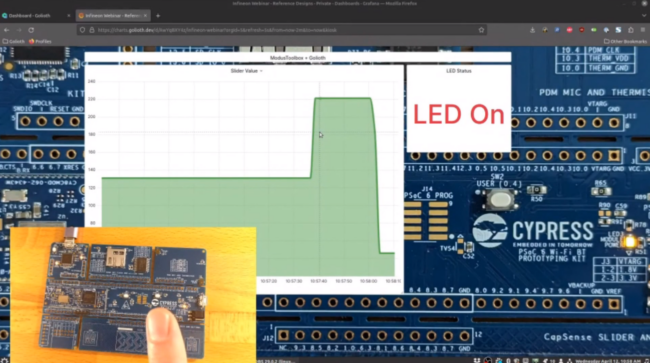A few weeks ago we held a live webinar with Infineon about how to collect sensor data using the Golioth ModusToolbox™ SDK and push that data up to the Golioth Cloud. I (Chris) was an audience member for the webinar and thought I would use my experience watching from the sidelines to comment on some things that I noticed during the video. You can watch the webinar in its entirety on YouTube now.
Starting from a low-cost dev kit
As a hardware engineer, the first thing I notice in any demonstration is the hardware the demo is running on. In this case, Mike was showcasing the SDK running on the PSOC™ 6 CY8CPROTO-062-4343W. This is a fun, low cost board (only $28 at Digikey) with the 4343W Wi-Fi module external to the main processor. It has Infineon’s signature capacitive touch controller capability on it.
The CAPSENSE™ feature is what Mike pulled into the demonstration. He utilized the touch controller to modify the brightness of an LED on a scale of 0-255. There are also cap-touch “push buttons” that can control the on/off state of that same LED. These are common use cases of cap-touch, but Mike was able to take these values and publish them to the cloud using Golioth. From there, it’s possible to view and/or chart the values in a visualization program like Grafana.

It’s not a large mental leap to consider this same function being used for larger LED lighting arrays or industrial control panels. With Golioth’s LightDB State, it’s also possible to modify the device side on/off behavior, but using the Cloud. Within the span of a few minutes, Mike was able to showcase what entire companies build their product functionality around. Golioth gives you these capabilities, just about “out of the box”.
The ModusToolbox™ Ecosystem
Clark from Infineon walked everyone through how ModusToolbox™ pulls together a bunch of tools. This feels like the evolution–and improvement–of the ways that IDEs used to work. Many of the same paradigms of pulling in sample code are there, but the tools are now external to an IDE (hardware and firmware engineers will recall the days of every IDE remaining captive within a customized Eclipse environment).
Now that the tools are external, you have the option to choose a wider variety of coding platforms to work from. This is a welcome change, especially as a VScode convert. Mike showed how it’s possible to boot up a new project using the examples pulled in through ModusToolbox™, while also configuring a VScode workspace for your project.
Under the hood, this is a FreeRTOS implementation. However, I am regularly calling out the difference between the RTOS (in this case, FreeRTOS) and the ecosystem (in this case, ModusToolbox™). The ecosystem is important to engineers, because this is the layer of integration that they really want: piecing together 3rd party plugins and a range of examples to get them started quickly. The engineers at Infineon have spent their time layering drivers on top of the FreeRTOS core and enabling a range of new features specific to their parts.
Since many engineers are starting from the context of a specific chipset, it’s important to understand the difference between RTOS and ecosystem, in my opinion. As a hardware engineer, I want the convenience of trying out a range of examples specific to my hardware, instead of building my own tooling from the ground up, which would be required if I was starting just from the FreeRTOS core. Granted, some firmware and software engineers might prefer a different flow.
Get started with Golioth and Infineon
Golioth takes you even further down the path to a functional demo that you can show to your team when trying out a PSOC™ 6 part in an IoT context to your team. The Golioth Firmware SDK enables you to jumpstart development and immediately open up a range of features on your project, such as:
- Over-the-Air Updates
- Databasing
- Settings service
- Remote Procedure Calls
- Device Health
After you watch the video above, sign up for a free Dev Tier Golioth Account, which gives you access to your first 50 devices on the platform for free. If you have any questions, check out our Forums or jump over to our Discord channel.


No comments yet! Start the discussion at forum.golioth.io